How to make roti canai with the Roti King
There are flatbreads – and then there are flatbreads. Roti canai (pronounced cha-NIGH) definitely falls into the latter camp. It’s a lightly enriched dough that’s stretched, then folded before it’s cooked, trapping air pockets within to create something fluffy on the inside and crisp on the outside. It is, in our opinion, the best flatbread out there.
Learn how to make roti canai with this step-by-step guide. Food-loving Londoners in the know queue up outside Roti King for Sugen Gopal’s superlative, freshly made flatbreads. Once you’ve mastered Sugen’s expert technique, your family and friends will also be getting in line for a taste….

The roti canai was a relatively obscure side dish in the UK until one man put it in the spotlight: Sugen Gopal. His Roti King restaurant in Euston (there are now additional London branches in Battersea and Waterloo) serves a simple menu of Malaysian classics – but it’s the roti canai that people queue for. “Roti canai was the first dish I really became passionate about,” says Sugen. “I’ve been making them since I was 14. When I came to the UK, nobody was really offering them, so I decided to make sure mine were better than anywhere else; that roti was seen as something special.”
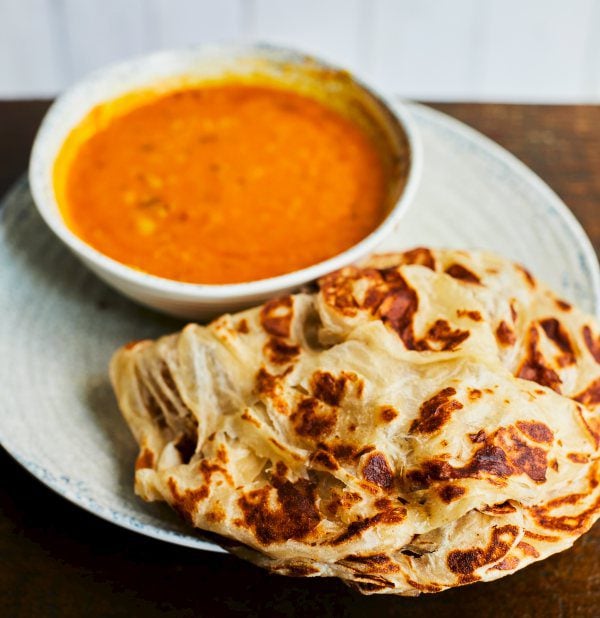
This Southeast Asian flatbread offers up a textural smorgasbord: crisp, flaky, fluffy, rich and light, all at the same time. While the ingredients are simple, the technique is one to master, so who better than Sugen – the Roti King himself – to show you how.
Originally from India but also heavily associated with the cuisines of Malaysia, Singapore (where it’s known as roti prata), Brunei and Thailand, roti canai has to be cooked and served fresh – which is why you’ll never see it for sale ready-made in the shops. It’s street food, pure and simple, served alongside a simple kari (dal or curry) for breakfast. When you get a really good roti canai, however, it outshines whatever dish it’s served with.
"This flaky, enriched flatbread might take a few attempts to get right, but when you finally crack the flip-and-slap method to get the dough wafer-thin, you’ll be on a roll."
Making roti canai at home is perfectly possible – the ingredients are simple and the initial process is straightforward. Where the skill lies, however, is in the ‘slapping’ and stretching of the dough – a technique that takes practice to learn (and decades to master). But if there’s anyone who can guide you through the dish, it’s Sugen.
The keys to success
The mix
Create a shaggy dough in a stand mixer with a dough hook (the Roti King can do it by hand but a stand mixer is easier), then feed in the butter a little at a time until smooth. After resting the dough divide it into smooth balls by taking a large piece and squeezing it out of the top of your fist, then pinching it off.
The overnight rest
The balls are then thoroughly coated with oil (or melted butter), nestled together on a tray, covered and left to rest overnight. Resting makes the dough more hydrated, improving the texture and making it easier to work with when it comes to the all-important stretching.
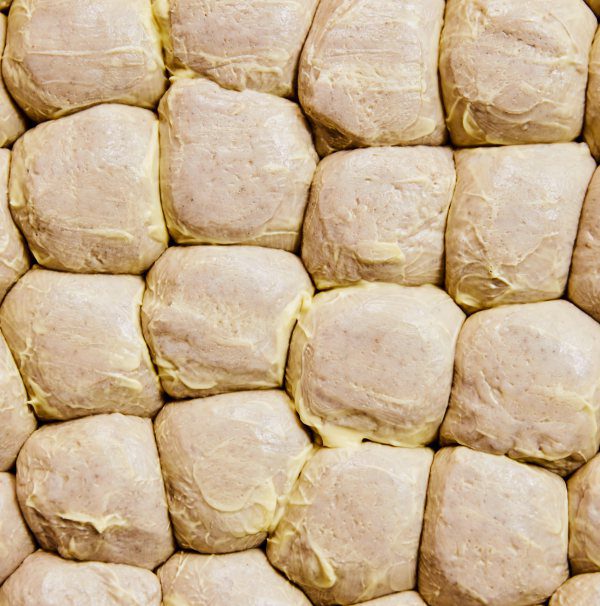
The initial stretch
Before you begin, make sure you have a large, clean work surface, a tray and your dough within arm’s reach. Then cover everything with oil, including your hands. The dough is being stretched very thin and you don’t want any risk of it sticking to anything – an ungreased surface, tray or hand will start to stick to the dough very quickly. Start with your hands, pushing and spreading the dough out onto the work surface, in the same way you’d shape a pizza. You want to use the palm of your hand to push the dough against the work surface in an outward motion, trying to keep it in a rough circle and with an even thickness all around. It will shrink every time you push outwards, but keep at it until it’s around 25cm in diameter and pretty thin – but don’t worry it can get even thinner.
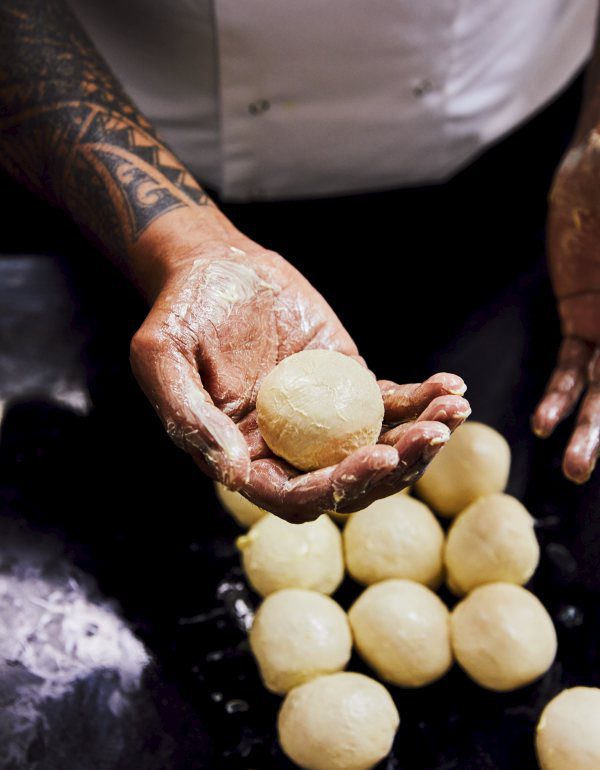
The slap and stretch
This is where the skill of making roti canai comes into play. “It’s all about practice,” says Sugen. “Before you even go near your dough, take a piece of wet kitchen paper and practise the slap motion with that. You need to be confident when stretching the dough in this way – don’t worry about it tearing as it can be easily fixed. If you’re getting nowhere, you can use a rolling pin and your hands to get the dough as thin as you possibly can, but slapping is the only way to make it as thin as it should be.”
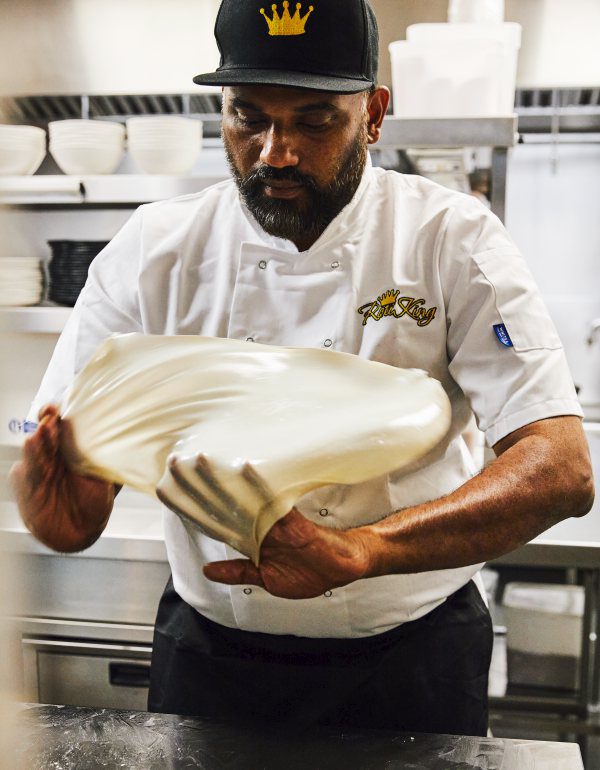
Before you start to slap, ensure your hands are oiled. Peel the dough off the counter, hold it with both hands, then spin and slap the dough back down in a smooth, confident motion, using one hand to guide and create the slap, a bit like you’re spreading out a picnic blanket, so it hits the work surface flat. The dough’s momentum will stretch it, with it hitting the counter before it tears itself in two. Repeat this at least 6 times, moving your hands round the dough slightly with each slap to ensure an even thickness all round (Sugen manages 10-12 slaps, but he is the Roti King – so don’t worry if you can’t take it this far).
The stretched dough should be like a window pane, almost completely translucent when it’s on the counter. Any folds can be unfolded and any tears can be bunched up (provided they’re not huge). This is not an easy task – it’s what makes this recipe a project! But practise with kitchen paper and don’t be downhearted if your first attempts don’t work out.
The fold
Once you have a super-thin, translucent sheet of dough on your counter, fold in all four sides to make it slightly bigger than the palm of your hand. You want to fold each side quite quickly, trying to trap as much air in the fold as possible to create air pockets and bubbles. Transfer the folded roti to an oiled tray, then repeat until they’re all made. Let the dough rest for a few minutes before cooking it.
The fry
Heat up a drizzle of oil in your pan, but don’t throw the roti in yet – it needs a final stretch out with your hands on the counter to bring it back to about a 15-20cm circle. It then just needs a few minutes in the pan, but don’t be tempted to turn it too often: “You shouldn’t need to flip the roti more than four times, so aim for once every 30 seconds,” says Sugen. “It’s ready when it’s covered in brown spots, and if your roti is a good one, it will puff up when the trapped air inside heats up.”
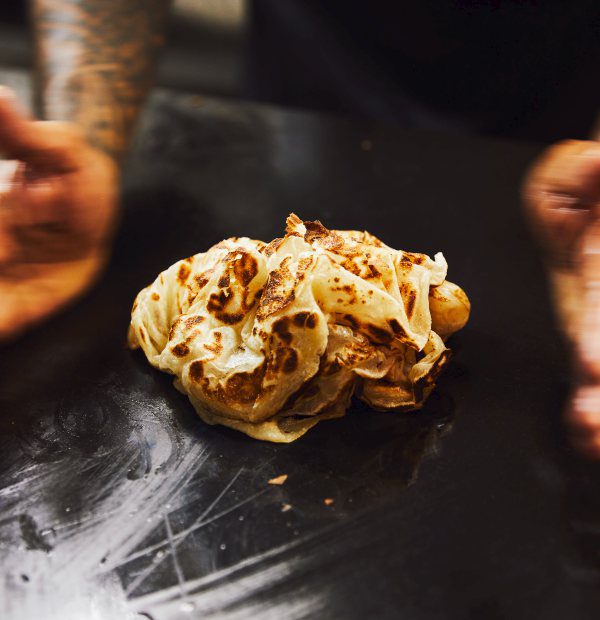
The clap
There’s just one thing left to do to your beautifully brown-spotted and crisp roti canai before you serve it – and it’s pretty unintuitive. You want to take your beautiful creation, put it between your hands on the work surface and clap a few times, breaking it up. This turns the crisp roti into a fluffy pile of torn-apart melt-in-the-mouth bread. An un-clapped roti will taste great but doesn’t fully showcase its incredible texture. Enjoy the steaming pile of roti immediately, scooping up whatever you’re serving it with in the process.
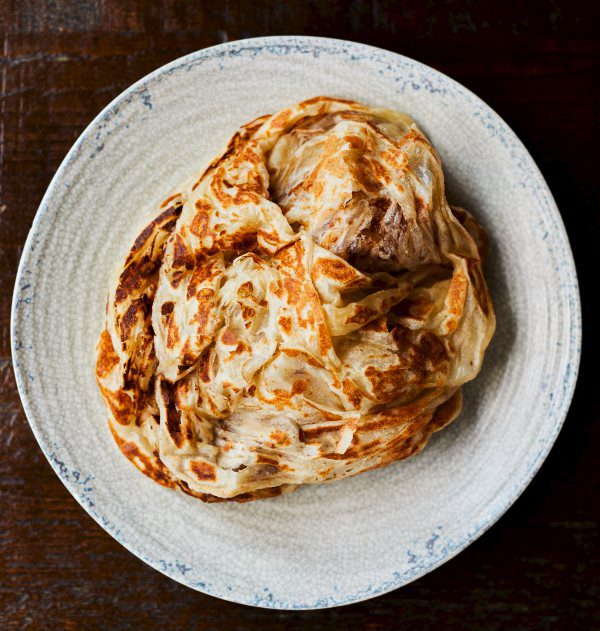
A final word of encouragement
Remember: making roti canai isn’t something you’ll nail perfectly on your first attempt. It takes practice. In the same way your first loaf of sourdough or the first pancake that hits the pan is never as good as your later attempts, it’s a process that gets better each time you do it. But that’s what makes it so rewarding – with every slap, fold, fry and clap, you’ll make a slightly better version than the one previously. And when you do get a roti canai that hits all those sweet spots – flaky, crisp, soft, fluffy – it is immensely satisfying. Just ask Sugen: he makes nearly 200 a day and he’s still not tired of it.

Now you’re ready to make the Roti King’s roti canai recipe…
Subscribe to our magazine
Food stories, skills and tested recipes, straight to your door... Enjoy 5 issues for just £5 with our special introductory offer.
Subscribe
Unleash your inner chef
Looking for inspiration? Receive the latest recipes with our newsletter